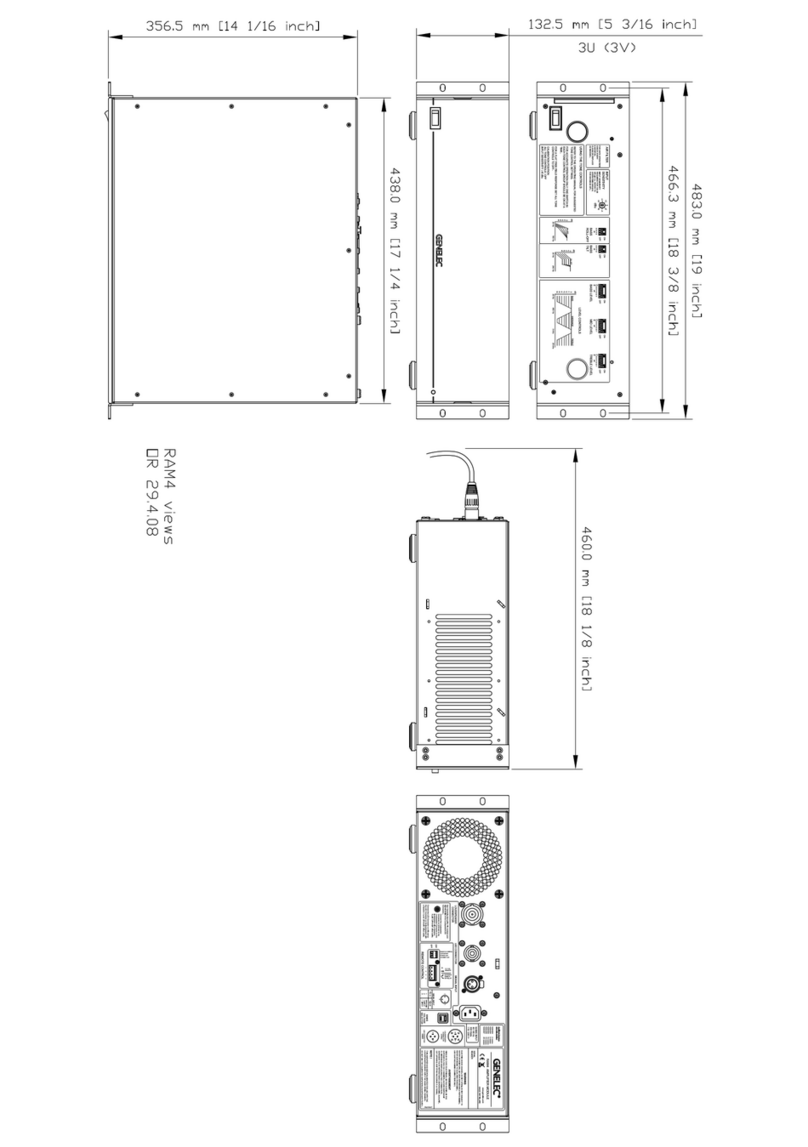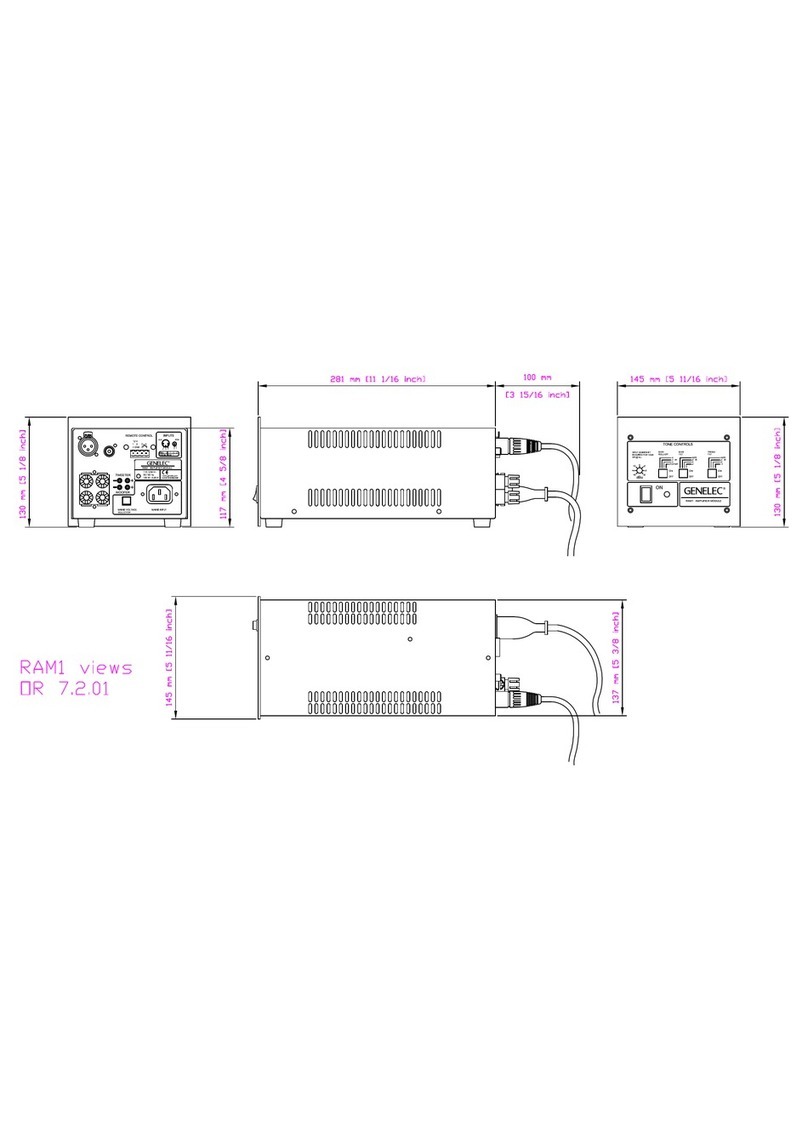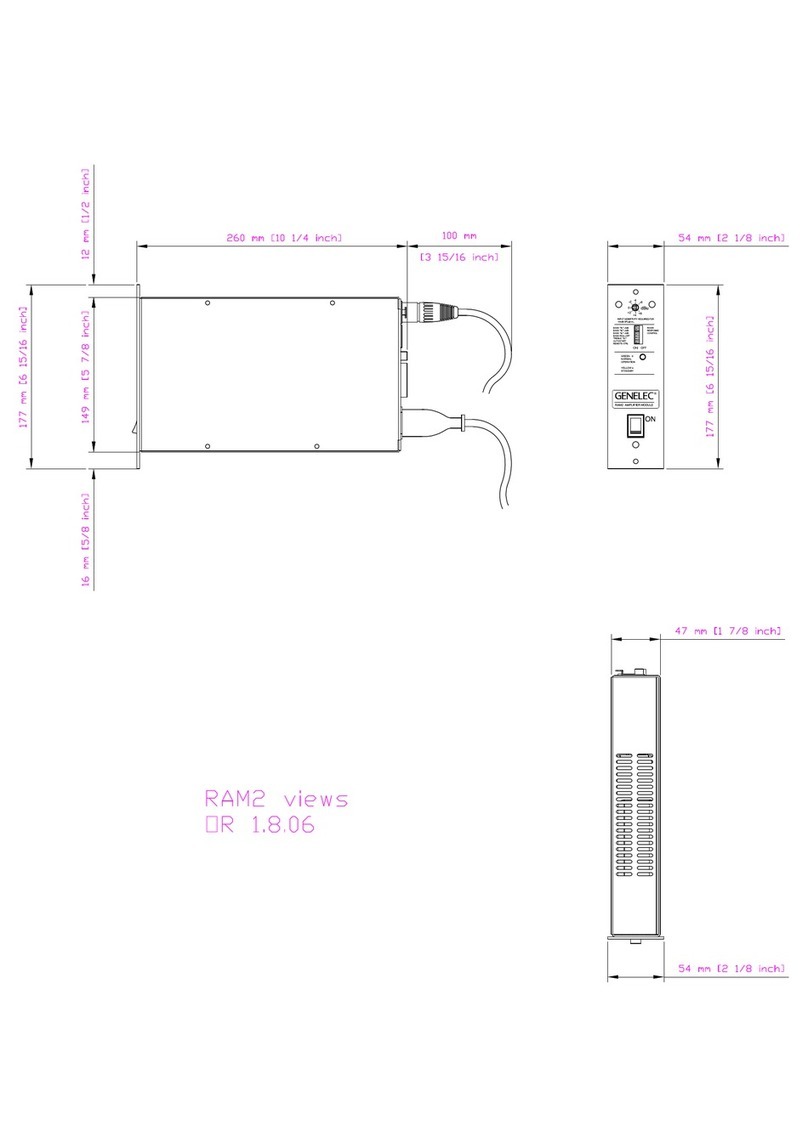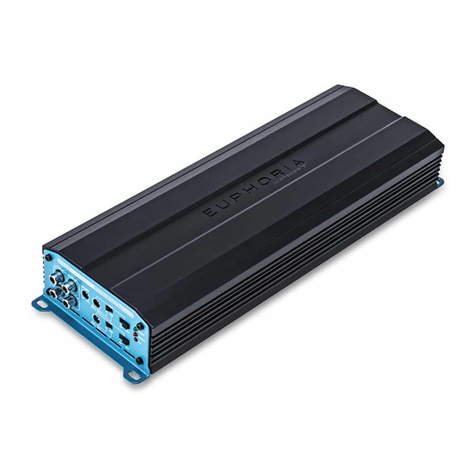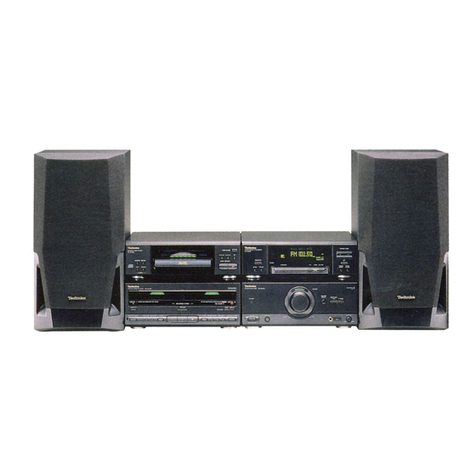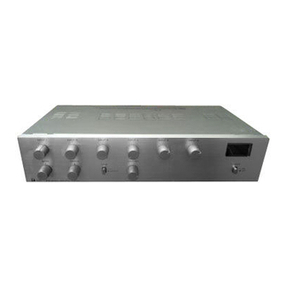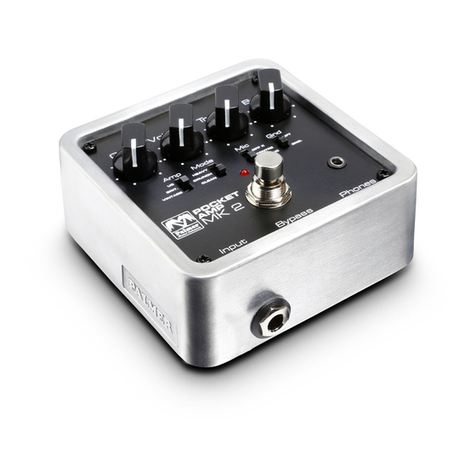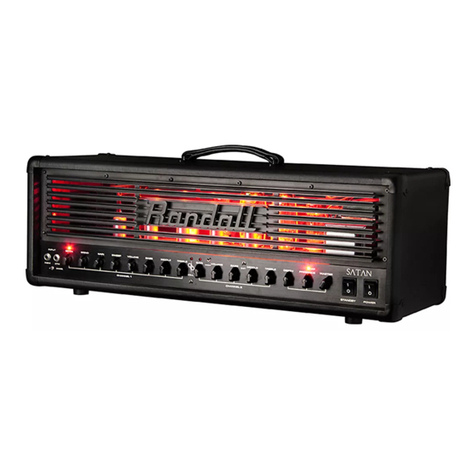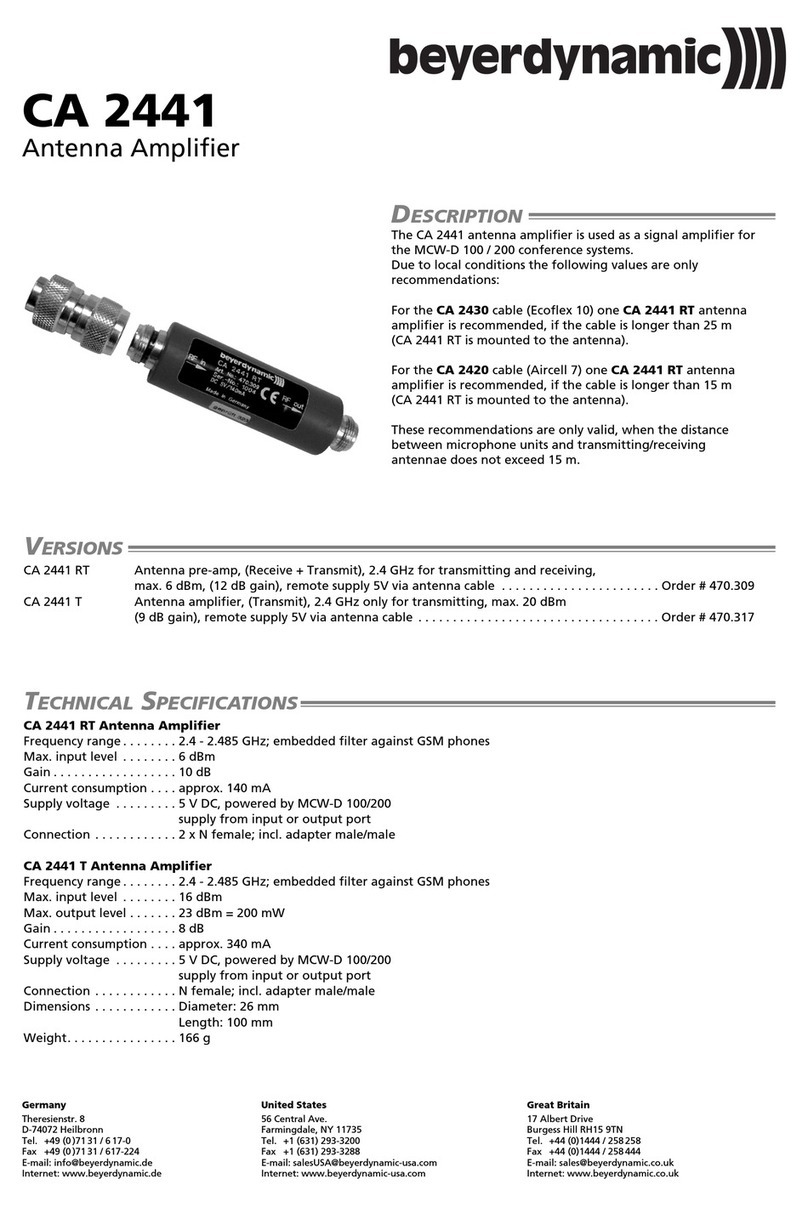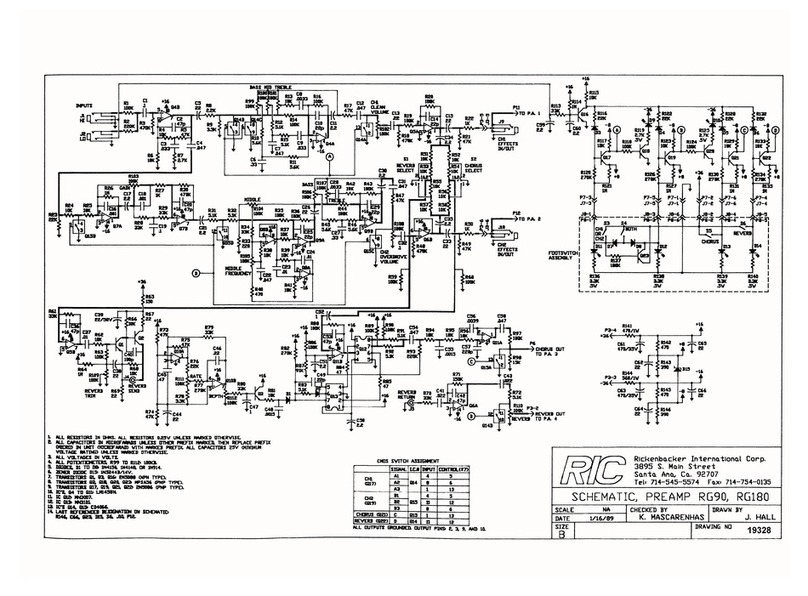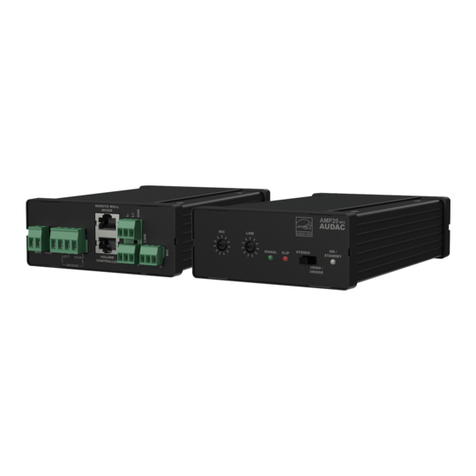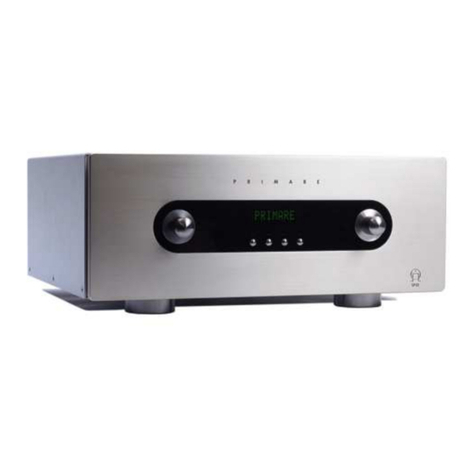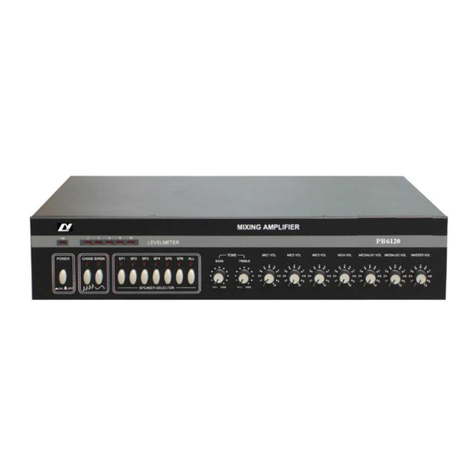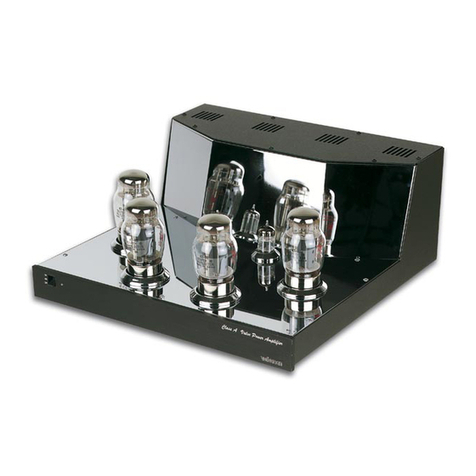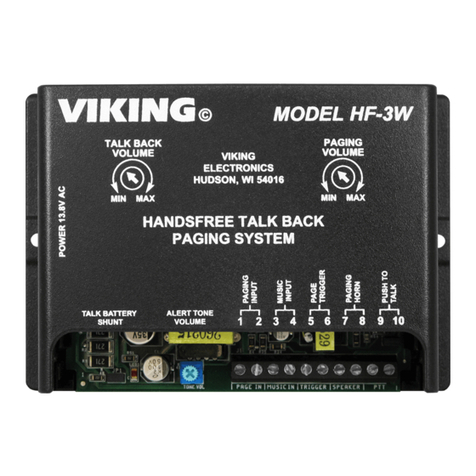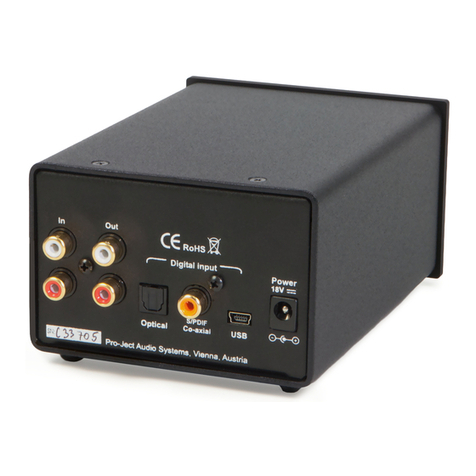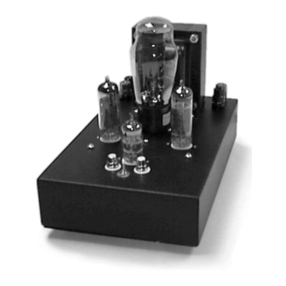Genelec ROSE User manual

ROSE COMPARISON OF AUDIO POWER AMPLIFIERS
AES 112
TH
CONVENTION, MUNICH, GERMANY, 2002 MAY 10–13 1
A Comparison of Modular State-of-the-Art Switch
Mode and Linear Audio Power Amplifiers
Darren Rose
Genelec OY, Iisalmi, Finland
ABSTRACT
Modern commercially available, compact, low power audio power amplifiers are mostly designed around one of
three main technologies. These are integrated circuit class AB, thick film hybrid class AB, and switch mode power
amplifier modules. The decision to use a particular technology is not only based on idealised performance
specifications, but also on the performance under realistic operating conditions, and cost-to-performance
considerations. In this study, the performance of each amplifier technology is studied in ideal and realistic operating
conditions with two amplifier designs for each technology category. Regulated and unregulated power supplies are
used, in combination with ideal resistive and real-life complex impedance loudspeaker loads. For a fixed nominal
supply voltage, the value of the different technologies with regard to noise, distortion and continuous output power
is discussed. This results in an analysis of the cost effectiveness, or value, of currently competing technologies for
high quality, low power, compact audio power amplifiers.
0. INTRODUCTION
Modular power amplifiers are almost universally chosen for low
power, compact, audio power amplifiers because of cost-
effectiveness and advantageous size-to-performance ratio.
The ever-growing list of modular power amplifiers makes selection
very difficult. Datasheets for available power amplifier modules
show the performance of the modules in various conditions, but do
not reveal the performance-to-cost ratio, or value. This paper stems
from the need to justify the choice to use a particular contemporary
power amplifier module, of a particular technology, when budget
restrictions are in place.
1. POWER AMPLIFIER CONFIGURATIONS
There are several classes of power amplifier configurations. The
configurations most commonly used in audio power amplifiers are
class AB and switch mode configurations.
1.1. Class AB Audio Power Amplifiers
Class AB power amplifiers have been used for decades in audio
reproduction, and have become well accepted. They are relatively
easy to design for mass production, and can be configured to give
almost any required output power. The total harmonic distortion
and noise (THD+N) can be reduced to 0.001% or less below
10kHz at reasonable output levels [1, p. 290]. This remaining
THD+N is mostly noise and crossover distortion.
It is possible to buy class AB power amplifiers as nearly complete
modules. These fall into two main categories: integrated circuit
(IC) and thick film hybrid (TFH). The IC is a circuit made on one
piece of silicon, normally encased in plastic, with metal legs. The
TFH is constructed from small discreet components mounted on an
aluminium substrate, which is then fitted with a plastic cover and
metal legs.
ICs are generally smaller and cheaper, with less output capability
and lower maximum operating voltages. They also tend to have
more comprehensive internal protection functions.

ROSE COMPARISON OF AUDIO POWER AMPLIFIERS
AES 112
TH
CONVENTION, MUNICH, GERMANY, 2002 MAY 10–13 2
The main disadvantage of the class AB power amplifier is low
efficiency, caused by losses in the output devices operated in their
linear regions. Depending on the bias current, the maximum
efficiency for a sinewave signal is theoretically just under 78.5%
[2, 3], but practically about 70% [3, p. 52]. With real music signals,
the efficiency is in the range of 30-50%, which makes it necessary
to dissipate significant amounts of heat from the amplifier. Class
AB ICs and TFHs are widely available, cost-effective, and used
widely in compact audio power amplifier products.
1.2. Switch Mode Audio Power Amplifiers
Switch mode amplifiers produce the output signal by pulse width
modulating and amplifying the input signal. This is demodulated
later by filtering out high frequency switching components either
in the loudspeaker driver itself or in a filter at the amplifier output
to recover the amplified signal.
Switch mode amplifier designs have existed since the 1960s, but
only relatively recently has the distortion performance been
improved sufficiently to use them for audio purposes [3].
Because the output devices are nominally either in cut-off or
saturation, the switch mode amplifier is very efficient. Its
efficiency is typically 80-90% for a sinewave signal. This is its
greatest advantage, significantly reducing the heat generated in the
amplifier.
One current disadvantage of the switch mode amplifier is
complexity of design, increased by the need to conform to stringent
EMC standards.
At the present time, complete switch mode amplifier modules are
available from several manufacturers. An increasing number of IC
manufacturers are also offering FET driver ICs and information
about how to incorporate them into switch mode amplifiers.
2. PERFORMANCE MEASUREMENTS
2.1. Idealised Versus Realistic Conditions
The specifications for a component or a whole system are often
given based on measurements taken in idealised conditions. This
provides a quick rough comparison for a broad range of operating
conditions. However, when a component is taken into use in a real
system, the operating conditions may differ significantly from
ideal. In the case of a power amplifier, the main conditions that
vary are the power supply and the load.
An ideal power supply for a power amplifier is regulated DC. This
kind of supply can easily be made for low current circuits such as
preamplifiers, but power amplifiers use very high current peaks.
High current regulated supplies can be constructed using switch
mode or linear technology, but are very rarely seen in low power
audio power amplifiers.
Commonly, the power supply is based on a transformer, full wave
rectification, and large reservoir capacitors for smoothing and
supplying current peaks. There is a voltage drop across the
resistance of the transformer windings. At high output power, this
manifests itself as a significant supply voltage reduction, lowering
the voltage headroom and hence usable output power of the power
amplifier. The size of the reservoir capacitors affects the available
peak current, and hence the peak power of the amplifier. Poor
smoothing can degrade the noise performance of a power amplifier.
Power amplifiers are mostly specified into 4Ωor 8Ωresistive
loads. These present a relatively easy load for the power amplifier.
In practice, audio power amplifiers are nearly always used with
moving coil loudspeakers. The drivers, typically mounted in vented
cabinets, present a complex load to the power amplifier with
significant reactive loading. The impedance minima are below the
nominal impedance of the driver, and the peaks around these are
typically many times the magnitude of the minimum impedance.
The phase of the load varies typically within the range of ±60°.
The result of these factors is that the amplifier has to dissipate
more power than with a resistive load. Some amplifiers become
unstable when used with highly reactive loads, or their
performance can be otherwise degraded.
2.2. Frequency Response
The frequency response of the amplifier is not critical for this
work, since the frequency response of the currently available
modules is more than sufficient for audio applications. In high
quality systems, the frequency response is limited prior to the
power amplifier by active filters, and tailored by tone controls. In a
complete reproduction system, deviation from flatness of response
is typically dominated by the loudspeaker. In this paper, frequency
response is simply checked for flatness in the typical range of
40Hz to 22kHz.
2.3. Noise
Noise generated by the amplifier is a very important consideration
because it may limit the available dynamic range of an audio power
amplifier and may annoy the user. Idle channel noise is also
regarded by some users as a measure of system quality. Output
noise voltage and equivalent input noise (EIN) are measured in this
study.
2.4. Distortion
As yet there is no widely recognised single measurement of
distortion that translates directly into perceived quality. The main
techniques of distortion measurement are harmonic distortion
(THD and THD+N) and various intermodulation distortion
measurements (SMPTE, CCIF, DIM/TIM) [4,5,6].
THD+N, the most widely used measurement, comes closest to
providing a single figure of merit to say that there are no major
problems in the device under test, particularly when measured at
several frequencies [7, p. 32, 8]. The subjective quality of a system
may be more dependent on its intermodulation distortion than its
harmonic distortion [9].
In this study the goal is comparative measurement of quality and
value of the different modules. THD+N values at various
frequencies using different loads and power supplies are measured
for this purpose.
2.5. Output Power
In this paper, continuous output power is measured at levels of
0.1% and 1% THD+N.
2.6. Efficiency
Efficiency is important in high power amplifiers with limited space
for heatsinks and cooling. In compact, low power, audio power
amplifiers, the mean power levels are typically low, and so the heat
generated in the amplifier can be dissipated relatively easily. For
this reason, efficiency is not directly measured in this paper.
3. DESCRIPTION OF AMPLIFIERS
There are many ways of choosing a set of amplifiers to test. By
choosing based on price, the benefits of an amplifier only slightly
out of the price range may go unnoticed. Choosing based on
performance specifications may also be misguided because the
amplifier may have been specified under ideal conditions, or under
different conditions to other amplifiers.
Power supply voltage level has great impact on reservoir capacitor
choice, efficiency, method of generating another set of voltages for
low voltage signal conditioning, etc. Most low power audio power
amplifiers use a voltage supply of ±25V to ±35V.
Amplifiers recommended for use with an output swing of about
±35V were chosen. This means a supply of ±35V for single ended
designs, or +35V and 0V for bridged designs. The chosen
amplifiers are commonly available, popular, and sold for use in
high quality systems. The amplifier descriptions can be seen in
table 1.
Table 1. Comparison of amplifier features

ROSE COMPARISON OF AUDIO POWER AMPLIFIERS
AES 112
TH
CONVENTION, MUNICH, GERMANY, 2002 MAY 10–13 3
Amp Technology Package Output stage Protection Other
supplies
1 Class AB IC Single-ended
BJT Yes No
2 Class AB IC Single-ended,
DMOS Yes No
3 Class AB TFH Single-ended
quasi-compl.
BJT
No No
4 Class AB TFH Single-ended,
compl. emitter-
follower BJT
No +12V
5 Switch
mode Demo
board Single-ended N-
ch. MOSFET No No
6 Switch
mode Complete
module H-Bridged N-ch.
MOSFET No ±12V
The six amplifiers represent five different manufacturers.
Amplifiers 1 to 4 were assembled with the extra components
required to make the circuit recommended in their datasheet, but
with equal input impedance. Components were placed on double-
sided PCBs with good ground planes on both sides. The PCBs
were specially designed for this work.
The gains of the amplifiers are different because of the
manufacturers’ recommendations. This has been accounted for in
calculating the equivalent input noise.
The heatsinks used are rectangles of 5mm thick aluminium sheet.
They are sufficient to keep the heatsink temperature rise to 40°or
less when an amplifier is playing music material.
4. DESCRIPTION OF POWER SUPPLIES
Mains voltage for the power supplies comes from a 3.5kVA variac.
For the unregulated power supply three toroidal mains transformers
are used. These have dual 0-25V secondary windings with ratings
60VA, 120VA and 250VA. The AC voltage is full wave rectified
by a diode bridge and smoothed by 4700µF reservoir capacitors.
This value was chosen because it is in common use. The value is
not very critical as the power output is measured for continuous
output power. The regulated power supply is based on LM317/337
voltage regulators with pass transistors and over-current protection.
Extra ±12V supplies needed by some amplifiers were provided by
a regulated laboratory power supply. Since power amplifiers
typically use little current from these supplies, it is fair to assume
that the low voltage supplies already in the audio system can be
used also for the power amplifier with no extra cost or reduction in
quality.
5. COST OF AMPLIFIER AND POWER SUPPLY
The costs of all parts are based on general mass production market
prices. The cost of the regulated power supply was not calculated
because it is not considered competitive for a low power audio
power amplifier. The costs (see fig. 1) were normalised to the cost
of the complete power amplifier solution based on amplifier 1
using a 60VA unregulated power supply.
There is no standard for incorporating the cost of an audio product
into its perceived quality to obtain its performance to cost ratio, or
value. In this case the normalised cost either multiplies
performance data for which a low figure represents high quality, or
divides performance data for which a high figure represents high
quality.
Breakdown of complete amplifier solution cost normalised to
amplifier 1 with a 60VA transformer based power supply
0
0.5
1
1.5
2
2.5
3
3.5
4
4.5
1(60)
1 (120)
1 (250)
2(60)
2 (120)
2 (250)
3 (60)
3 (120)
3 (250)
4(60)
4 (120)
4 (250)
5(60)
5 (120)
5 (250)
6 (60)
6 (120)
6 (250)
Amplifier number (Power supply /VA)
Normalised cost
Heatsinking
Power supply components
Other components
Amplifier module
Fig. 1. Breakdown of amplifier costs, normalised to amplifier 1,
assuming a 60VA unregulated power supply.
6. MEASUREMENTS
Before any measurements were made, the power supplies and
amplifiers were tested to ensure that they function as expected
without oscillation, unusually high noise, or distortion. All
measurements were made using the same measurement system
†
.
6.1. Frequency response and Noise
The 60VA unregulated power supply was used in these
measurements. With the amplifier connected to an 8Ωresistive
load the frequency response was measured to be sure that it is flat
(±0.2dB) from 40Hz to 22kHz. The gain was recorded and can be
seen in table 2.
To measure noise, the amplifier input was grounded. The load was
disconnected because is a very open construction that, especially
with connected wires, acts as an antenna, picking up 50Hz
magnetic noise from the lab space. The bandwidth of the
measurement system was set to 21kHz, using an AES17 20kHz
brickwall filter. The A-weighted noise voltage at the amplifier
output was measured. The results can be seen in table 2.
Table 2. Cost, noise and gain. EIN – equivalent input noise. All
noise voltages are A-weighted.
Amplifier 1 2 3 4 5 6
Technology AB
IC AB
IC AB
TFH AB
TFH sw.
mode sw.
mode
Normalised Cost 1.00 1.06 1.10 1.12 1.63 3.44
Noise voltage (µV) 55 32 25 21 165 76
Gain (dB) 24.0 30.4 33.6 30.0 25.3 27.0
EIN (µV) 3.47 0.97 0.52 0.66 8.96 3.39
EIN x normalised cost 3.47 1.02 0.58 0.74 14.64 11.67
6.2. Determining the loudspeaker load
The impedance of a typical nominal 4Ωloudspeaker bass driver in
a vented cabinet was measured from 10Hz to 1kHz. The tuning
frequency of the cabinet was found to be 35Hz. The first phase
maximum above this is +30.3°at 58Hz, where the impedance
magnitude is 5.86Ω. All tests using a real loudspeaker as a load
used this driver in this cabinet.
Due to the spectral content of music, more power is needed at low
frequencies. Because of driver and cabinet resonances, it is at low
frequencies that the loudspeaker load is most different to the
resistive load. For these reasons, the output power and distortion
tests with the loudspeaker load were carried out only at 58Hz.
†
Audio Precision System Two Cascade Plus

ROSE COMPARISON OF AUDIO POWER AMPLIFIERS
AES 112
TH
CONVENTION, MUNICH, GERMANY, 2002 MAY 10–13 4
6.3. Continuous output power
The input to the amplifier, a fixed frequency sinewave, was ramped
up slowly and the power output and THD+N were recorded in a
21kHz bandwidth set by an AES17 20kHz brickwall filter. At
58Hz, each amplifier was tested with 4Ωresistive, 8Ωresistive,
and loudspeaker loads. In the case of the loudspeaker load, the
measured power is based on the amplifier output voltage and the
real part of the loudspeaker impedance (5.06Ω) to measure the
power dissipated in the driver. Other test frequencies were chosen
to cover the rest of the audio band. 1kHz was chosen because it is a
standard frequency for testing, 7kHz was chosen as the highest
frequency that has the third harmonic in a 21kHz bandwidth. 14
kHz was chosen because it represents the high end of the audio
bandwidth and its third harmonic is within 42kHz, another standard
AES17 filter bandwidth. The assumption made here was that the
harmonics would decrease in amplitude as their order increases and
the THD+N level as measured from these is representative of the
true unlimited bandwidth values.
At 1kHz, 7kHz and 14kHz, the loads used were 4Ωresistive and
8Ωresistive. In the 14kHz case, the measurement system
bandwidth was increased to 42kHz by using an AES17 40kHz
brickwall filter
The output power for 0.1% and 1% THD+N was recorded to the
nearest 0.5W. The comparisons of results can be seen in appendix
A where Figs. 1-9 show continuous power outputs of the amplifiers
with different power supplies, at different frequencies and with
different loads.
Figs. 10-18 in appendix A show the value of the amplifier, heatsink
and power supply combination in terms of the output power. This
could be considered the measure of “bang for the buck”, or a
measure of value for money. They are shown as 10log(power/total
cost) for simple viewing. The total cost has been normalised to the
cost of amplifier 1 with a 60VA unregulated power supply.
6.4. Distortion at a known power
Using the data generated in section 6.3., it is possible to read the
THD+N at any output power. The power chosen was the power
when the output voltage swing is ±17.5V, half the theoretical
lossless maximum. This corresponds to 19W into an 8Ωresistive
load, 38W into a 4Ωresistive load, and 30W into the real part of
the loudspeaker load at 58Hz. The results are seen in the appendix
B, figs. 1-9.
To compare the value of the amplifiers in terms of their distortion,
the THD+N was multiplied by the total cost of the amplifier,
heatsink and power supply combination. The costs were
normalised to the cost of amplifier 1 with the 60VA unregulated
power supply. The results are shown in appendix B, figs. 10-18.
7. RESULTS AND DISCUSSION
7.1. Noise
This section discusses table 2. The lowest absolute output noise
voltage and EIN are shown by the TFHs (amplifiers 3 and 4). The
switch mode amplifiers (5 and 6) show the poorest noise
performance. Amplifier 2, an IC, comes close to the EIN
performance of the TFHs.
In most cases, higher output noise also means higher EIN, but in
the case of amplifier 1, with quite low output noise the EIN is quite
high because of its low gain. The noise performance of linear
amplifier modules, particularly TFHs is currently better than that of
switch mode amplifier modules.
7.2. Value In Terms Of Noise
This section discusses table 2. If EIN multiplied by normalised cost
is an inverse measure of value, then the TFH power amplifier
modules (3 and 4) have the highest value, followed by the ICs (1
and 2). The switch mode amplifiers (5 and 6) are considerably
lower in value. In terms of noise performance, linear amplifiers
currently offer higher value than switch mode amplifiers. Among
linear amplifiers, TFHs offer more value than ICs.
7.3. Continuous Output Power
This section discusses the main features of figs. 1-9 in appendix A.
The continuous power output performance of the IC amplifiers (1
and 2) is often degraded by their protection circuitry, particularly at
low frequencies with a 4Ωresistive load. Some data could not be
measured for amplifier 1 at high frequencies because it is unstable
and the measurement sweep could not be completed. Data are also
missing for amplifier 5 at high frequencies at 0.1% THD+N
because the output at all power levels had greater than 0.1%
THD+N. In terms of continuous power output, the amplifiers
perform similarly with the 8Ωresistive load at 1kHz and 7kHz.
These results are particularly interesting for two reasons. Firstly,
linear amplifiers perform similarly while switch mode amplifiers
show clearly different output power to each other. This suggests
that switch mode technology is not as mature as linear technology
because the optimum performance has not been found by all
manufacturers. Secondly, the most common use of switch mode
amplifiers is as bass amplifiers, but these results suggest that their
efficiency advantage over linear amplifiers is greater at high
frequencies.
With the loudspeaker load at low frequencies, the performance
comparison resembles the performance comparison with the 8Ω
resistive load. When the supply voltage is kept constant, the
maximum output power from any non-protecting amplifier
increases with the VA rating of the transformer. The output of the
TFH amplifiers appears to almost double from the 60VA
unregulated power supply to the regulated supply. In many cases,
the switch mode amplifiers show a higher output than the linear
amplifiers when using the lower rated supplies. This is particularly
the case at higher frequencies, with the 4Ωresistive load, and at the
1% THD+N level. It is caused by the greater efficiency of the
amplifier topology.
The IC amplifiers (1 and 2) do not always show a higher
continuous power output when used with a larger power supply,
and they do not perform as well as TFHs with low impedance
loads. The TFH amplifiers (3 and 4) show the most consistent
output capacity at different frequencies. One of the switch mode
amplifiers has higher output at low frequencies, while the other has
higher output at higher frequencies.
7.4. Value In Terms Of Continuous Output Power
This section discusses figs. 10-18 in appendix A. In this section,
high value means high continuous output power to cost ratio.
With all loads, and at all frequencies, it can be seen that the linear
amplifier solutions (1-4) offer the highest value, and show similar
performance. Switch mode amplifier 5 offers less value, and
amplifier 6 offers considerably less.
At low frequencies with the 4Ωresistive load, amplifier 1 offers
lower value for higher VA rated power supplies. This is because its
internal protection circuitry reduces the available output power.
At low frequencies, the amplifiers offer similar value for both 0.1%
and 1% THD+N levels. At higher frequencies, the value at the
0.1% THD+N level is very much lower for some amplifiers
because of increased distortion levels. Switch mode amplifier 5 is
the most affected by this phenomenon.
In the case of an amplifier functioning normally with no adverse
protection circuitry effects, value with different transformers is
similar. This suggests that a larger transformer is money well spent.
When looking for the optimum transformer rating, in most cases,
the 120VA transformer offers the highest value. This is a
combination of the higher performance and low cost increase
compared to the 60VA power supply. This suggests that for any
given power supply voltage and load, there is an ideal transformer
rating to give optimum value.

ROSE COMPARISON OF AUDIO POWER AMPLIFIERS
AES 112
TH
CONVENTION, MUNICH, GERMANY, 2002 MAY 10–13 5
7.5. Distortion At A Known Power
This section discusses figs. 1-9 in appendix B. Some data are
missing for IC amplifiers 1 and 2 because their poorly designed
internal protection circuitry prevents them from reaching the
required output power levels. At low frequencies, particularly with
the 4Ωresistive load, it is very difficult to see trends in the results
because the protection circuits in the ICs (amplifiers 1 and 2) and
current limiting effects increase THD+N at some output powers.
When the amplifiers function normally with no protection or
current limiting problems, the differences between measurements
using different power supplies appear random. There should be no
difference with power supplies of good quality because the power
at which THD+N is measured is well below the point at which hard
clipping occurs. It is not limited by the power supply voltage level,
but by the non-linearity of the amplifier.
Amplifiers 3, 5 and 6 are the most consistent in their THD+N
performance. This in itself is a benefit. With the loudspeaker load,
differences in THD+N between the amplifiers are very small.
The performance of the amplifiers is most similar at lower
frequencies and with the loudspeaker load. The linear amplifiers
(1-4) show the lowest THD+N, although the performance of the
ICs (1 and 2) is degraded by poorly designed internal protection
circuitry. At high frequencies the spread between amplifiers is
significantly greater. TFH amplifier 3 shows the most consistent
THD+N performance across frequency.
7.6. Value In Terms Of Distortion
This section discusses figs. 10-18 in appendix B, in which high
THD+N multiplied by normalised cost is thought of as low value.
In many cases, the amplifier solution using the 60VA transformer
appears to have the greatest value. This is because of its lower cost.
Trends are hard to see again, for the same reasons outlined in the
previous section.
At low frequencies with the 4Ωresistive load the value offered by
the IC amplifiers (1 and 2) is often low because of the performance
degradation caused by their poorly designed internal protection
circuitry.
With the loudspeaker load, the values offered by the different
amplifiers are more equal. Amplifiers 1-3 offer the most value,
followed by 4, 6 and 5.
The spread of value offered by amplifiers is wide. Switch mode
amplifiers offer less value than linear amplifiers because they show
poorer performance and have a higher cost. The most consistent,
high value across frequency and with different loads is shown by
TFH amplifier 3.
8. SUMMARY
The aim of the work was to compare a set of currently
commercially available power amplifier modules for use in high
quality, low power, compact audio power amplifiers. The cost of
mass-produced amplifier solutions using these amplifiers with
various power supplies was calculated. The amplifiers were tested
in ideal and realistic conditions. Equivalent input noise, output
power and THD+N at a known power were measured for each
amplifier while varying the power supply and load. Combining the
normalised cost of the amplifiers with the measurement results, the
relative value of the amplifier solutions was calculated.
The IC based amplifier solutions are the cheapest, closely followed
by the TFH based solutions. For these types of amplifier solutions,
the power supply accounts for most of the cost, and amplifier
circuit cost is non-critical. The switch mode amplifier solution
costs are more varied, but for a given power supply, more
expensive because of the higher cost of the amplifier section.
The real loudspeaker load increases amplifier distortion compared
to resistive loads, but a comparison of continuous power output
between different amplifiers is similar to that of an 8Ωresistive
load.
Using an unregulated power supply reduces the output of an
amplifier compared to a regulated power supply. Switch mode
amplifiers are least affected by this. In this work, it was found that
there is an optimum size of transformer for given voltage and load
conditions, regardless of amplifier choice.
The switch mode amplifiers showed greater variation in
performance and cost than the linear amplifiers. This suggests that
switch mode technology is not yet mature enough to produce
consistent and competitive value for audio applications.
Of the six amplifiers tested, the most value overall is currently
offered by TFH amplifiers. Switch mode amplifiers offer the least
value, and there appears to be little justification at the present time
for using them in high quality, low power, compact audio power
amplifiers.
9. ACKNOWLEDGEMENTS
The author would like to thank his colleagues in the Research and
Development department at Genelec Oy for their patient help in
proof reading this document, and particularly Aki Mäkivirta for
inspiration and advice.
REFERENCES
[1] Douglas Self, “Self on audio”, Newnes, 2000, Oxford, ISBN 0-
7506-4765-5.
[2] Adel S. Sedra and Kenneth C. Smith, “Microelectronic
circuits”, third edition, Saunders College Publishing, 1991,
Orlandoo, ISBN 0-03-051648-X.
[3] G. Randy Sloane, “High power audio amplifier construction
manual”, McGraw-Hill, 1999, New York, ISBN 0-07-134119-6.
[3] Karsten Nielsen, “High fidelity PWM-based amplifier concept
for active loudspeaker systems with very low energy
consumption,” JAES, vol. 45, pp. 554 – 570, July 1997.
[4] SMPTE recommended practice “RP120-1994”, SMPTE, 1994.
[5] International Telephonic Consultative Committee (CCIF),
Document no. 11 of the Commission Mixte, CCIF/UIR, March
1937
[6] Eero Leinonen et al, “A method for measuring transient
intermodulation distortion”, JAES, vol 25, pp170-177, April 1977
[7] Bob Metzler, “Audio measurement handbook”, Audio
Precision, 1993, Beaverton.
[8] Richard Cabot, “Comparison of nonlinear distortion
measurement methods”, Proceedings of the AES 11th International
Conference, paper 11-0007, May 1992
[9] Eugene Czerwinski et al., “Multitone testing of sound system
components – some results and conclusions, part 1: History and
theory”, JAES, vol. 49, pp 1011-1048, November 2001

ROSE COMPARISON OF AUDIO POWER AMPLIFIERS
AES 112
TH
CONVENTION, MUNICH, GERMANY, 2002 MAY 10–13 6
APPENDICES
Appendix A. Continuous output power comparison
charts
58Hz, 4 ohm resisitve load
0.0
20.0
40.0
60.0
80.0
100.0
120.0
140.0
160.0
123456
Amplifier
Power (W)
60VA, 0.1%
120VA, 0.1%
250VA, 0.1%
Reg. 0.1%
60VA, 1%
120VA, 1%
250VA, 1%
Reg. 1%
Fig. 1. Continuous output power of amplifiers at 58Hz into a 4Ω
resistive load. Measured with all power supplies at 0.1% and 1%
THD+N
58Hz, 8 ohm resisitve load
0.0
10.0
20.0
30.0
40.0
50.0
60.0
70.0
80.0
123456
Amplifier
Power (W)
60VA, 0.1%
120VA, 0.1%
250VA, 0.1%
Reg. 0.1%
60VA, 1%
120VA, 1%
250VA, 1%
Reg. 1%
Fig. 2. Continuous output power of amplifiers at 58Hz into an 8Ω
resistive load. Measured with all power supplies at 0.1% and 1%
THD+N
58Hz, loudspeaker load
0.0
20.0
40.0
60.0
80.0
100.0
120.0
140.0
123456
Amplifier
Power (W)
60VA, 0.1%
120VA, 0.1%
250VA, 0.1%
Reg. 0.1%
60VA, 1%
120VA, 1%
250VA, 1%
Reg. 1%
Fig. 3. Real part of continuous amplifier output power at 58Hz into
the loudspeaker load. Measured with all power supplies at 0.1%
and 1% THD+N
1kHz, 4 ohm resisitve load
0.0
20.0
40.0
60.0
80.0
100.0
120.0
140.0
160.0
123456
Amplifier
Power (W)
60VA, 0.1%
120VA, 0.1%
250VA, 0.1%
Reg. 0.1%
60VA, 1%
120VA, 1%
250VA, 1%
Reg. 1%
Fig. 4. Continuous output power of amplifiers at 1kHz into a 4Ω
resistive load. Measured with all power supplies at 0.1% and 1%
THD+N
1kHz, 8 ohm resisitve load
0.0
10.0
20.0
30.0
40.0
50.0
60.0
70.0
80.0
123456
Amplifier
Power (W)
60VA, 0.1%
120VA, 0.1%
250VA, 0.1%
Reg. 0.1%
60VA, 1%
120VA, 1%
250VA, 1%
Reg. 1%
Fig. 5. Continuous output power of amplifiers at 1kHz into an 8Ω
resistive load. Measured with all power supplies at 0.1% and 1%
THD+N
7kHz, 4 ohm resisitve load
0.0
20.0
40.0
60.0
80.0
100.0
120.0
140.0
123456
Amplifier
Power (W)
60VA, 0.1%
120VA, 0.1%
250VA, 0.1%
Reg. 0.1%
60VA, 1%
120VA, 1%
250VA, 1%
Reg. 1%
Fig. 6. Continuous output power of amplifiers at 7kHz into a 4Ω
resistive load. Measured with all power supplies at 0.1% and 1%
THD+N

ROSE COMPARISON OF AUDIO POWER AMPLIFIERS
AES 112
TH
CONVENTION, MUNICH, GERMANY, 2002 MAY 10–13 7
7kHz, 8 ohm resisitve load
0
10
20
30
40
50
60
70
80
123456
Amplifier
Power (W)
60VA, 0.1%
120VA, 0.1%
250VA, 0.1%
Reg. 0.1%
60VA, 1%
120VA, 1%
250VA, 1%
Reg. 1%
Fig. 7. Continuous output power of amplifiers at 7kHz into an 8Ω
resistive load. Measured with all power supplies at 0.1% and 1%
THD+N
14kHz, 4 ohm resisitve load
0
20
40
60
80
100
120
140
123456
Amplifier
Power (W)
60VA, 0.1%
120VA, 0.1%
250VA, 0.1%
Reg. 0.1%
60VA, 1%
120VA, 1%
250VA, 1%
Reg. 1%
Fig. 8. Continuous output power of amplifiers at 14kHz into a 4Ω
resistive load. Measured with all power supplies at 0.1% and 1%
THD+N
14kHz, 8 ohm resisitve load
0
10
20
30
40
50
60
70
80
90
123456
Amplifier
Power (W)
60VA, 0.1%
120VA, 0.1%
250VA, 0.1%
Reg. 0.1%
60VA, 1%
120VA, 1%
250VA, 1%
Reg. 1%
Fig. 9. Continuous output power of amplifiers at 14kHz into an 8Ω
resistive load. Measured with all power supplies at 0.1% and 1%
THD+N
58Hz, 4 ohm resisitve load
0
2
4
6
8
10
12
14
16
18
20
123456
Amplifier
10log (power/total cost)
60VA, 0.1%
120VA, 0.1%
250VA, 0.1%
60VA, 1%
120VA, 1%
250VA, 1%
Fig. 10. Ratio of continuous output power and total cost at 58Hz
into a 4Ωresistive load. Measured for all amplifiers and
unregulated power supplies at 0.1% and 1% THD+N
58Hz, 8 ohm resisitve load
0
2
4
6
8
10
12
14
16
18
123456
Amplifier
10log (power/total cost)
60VA, 0.1%
120VA, 0.1%
250VA, 0.1%
60VA, 1%
120VA, 1%
250VA, 1%
Fig. 11. Ratio of continuous output power and total cost at 58Hz
into an 8Ωresistive load. Measured for all amplifiers and
unregulated power supplies at 0.1% and 1% THD+N
58Hz, loudspeaker load
0
2
4
6
8
10
12
14
16
18
20
123456
Amplifier
10log (power/total cost)
60VA, 0.1%
120VA, 0.1%
250VA, 0.1%
60VA, 1%
120VA, 1%
250VA, 1%
Fig. 12. Ratio of continuous output power and total cost at 58Hz
into the loudspeaker load. Measured for all amplifiers and
unregulated power supplies at 0.1% and 1% THD+N

ROSE COMPARISON OF AUDIO POWER AMPLIFIERS
AES 112
TH
CONVENTION, MUNICH, GERMANY, 2002 MAY 10–13 8
1kHz, 4 ohm resisitve load
0
2
4
6
8
10
12
14
16
18
20
123456
Amplifier
10log (power/total cost)
60VA, 0.1%
120VA, 0.1%
250VA, 0.1%
60VA, 1%
120VA, 1%
250VA, 1%
Fig. 13. Ratio of continuous output power and total cost at 1kHz
into a 4Ωresistive load. Measured for all amplifiers and
unregulated power supplies at 0.1% and 1% THD+N
1kHz, 8 ohm resisitve load
0
2
4
6
8
10
12
14
16
18
123456
Amplifier
10log (power/total cost)
60VA, 0.1%
120VA, 0.1%
250VA, 0.1%
60VA, 1%
120VA, 1%
250VA, 1%
Fig. 14. Ratio of continuous output power and total cost at 1kHz
into an 8Ωresistive load. Measured for all amplifiers and
unregulated power supplies at 0.1% and 1% THD+N
7kHz, 4 ohm resisitve load
0
2
4
6
8
10
12
14
16
18
20
123456
Amplifier
10log (power/total cost)
60VA, 0.1%
120VA, 0.1%
250VA, 0.1%
60VA, 1%
120VA, 1%
250VA, 1%
Fig. 15. Ratio of continuous output power and total cost at 7kHz
into a 4Ωresistive load. Measured for all amplifiers and
unregulated power supplies at 0.1% and 1% THD+N
7kHz, 8 ohm resisitve load
0
2
4
6
8
10
12
14
16
18
123456
Amplifier
10log (power/total cost)
60VA, 0.1%
120VA, 0.1%
250VA, 0.1%
60VA, 1%
120VA, 1%
250VA, 1%
Fig. 16. Ratio of continuous output power and total cost at 7kHz
into an 8Ωresistive load. Measured for all amplifiers and
unregulated power supplies at 0.1% and 1% THD+N
14kHz, 4 ohm resisitve load
0
2
4
6
8
10
12
14
16
18
20
123456
Amplifier
10log (power/total cost)
60VA, 0.1%
120VA, 0.1%
250VA, 0.1%
60VA, 1%
120VA, 1%
250VA, 1%
Fig. 17. Ratio of continuous output power and total cost at 14kHz
into a 4Ωresistive load. Measured for all amplifiers and
unregulated power supplies at 0.1% and 1% THD+N
14kHz, 8 ohm resisitve load
0
2
4
6
8
10
12
14
16
18
123456
Amplifier
10log (power/total cost)
60VA, 0.1%
120VA, 0.1%
250VA, 0.1%
60VA, 1%
120VA, 1%
250VA, 1%
Fig. 18. Ratio of continuous output power and total cost at 14Hz
into an 8Ωresistive load. Measured for all amplifiers and
unregulated power supplies at 0.1% and 1% THD+N

ROSE COMPARISON OF AUDIO POWER AMPLIFIERS
AES 112
TH
CONVENTION, MUNICH, GERMANY, 2002 MAY 10–13 9
Appendix B. Comparison charts for THD+N at a known
power
THD+N at 38W, 58Hz, 4 ohm resisitve load
0.001
0.01
0.1
123456
Amplifier
THD+N (%)
60VA
120VA
250VA
Reg
Fig. 1. THD+N of amplifiers at 58Hz outputting 38W into a 4Ω
resistive load. Measured with all power supplies.
THD+N at 19W, 58Hz, 8 ohm resisitve load
0.001
0.01
0.1
123456
Amplifier
THD+N (%)
60VA
120VA
250VA
Reg
Fig. 2. THD+N of amplifiers at 58Hz outputting 19W into an 8Ω
resistive load. Measured with all power supplies.
THD+N at 30W, 58Hz, loudspeaker load
0.001
0.01
0.1
123456
Amplifier
THD+N (%)
60VA
120VA
250VA
Reg
Fig. 3. THD+N of amplifiers at 58Hz outputting 30W into the
loudspeaker load. Measured with all power supplies.
THD+N at 38W, 1kHz, 4 ohm resisitve load
0.001
0.01
0.1
123456
Amplifier
THD+N (%)
60VA
120VA
250VA
Reg
Fig. 4. THD+N of amplifiers at 1kHz outputting 38W into a 4Ω
resistive load. Measured with all power supplies.
THD+N at 19W, 1kHz, 8 ohm resisitve load
0.001
0.01
0.1
123456
Amplifier
THD+N (%)
60VA
120VA
250VA
Reg
Fig. 5. THD+N of amplifiers at 1kHz outputting 19W into an 8Ω
resistive load. Measured with all power supplies.
THD+N at 38W, 7kHz, 4 ohm resisitve load
0.001
0.01
0.1
1
123456
Amplifier
THD+N (%)
60VA
120VA
250VA
Reg
Fig. 6. THD+N of amplifiers at 7kHz outputting 38W into a 4Ω
resistive load. Measured with all power supplies.

ROSE COMPARISON OF AUDIO POWER AMPLIFIERS
AES 112
TH
CONVENTION, MUNICH, GERMANY, 2002 MAY 10–13 10
THD+N at 19W, 7kHz, 8 ohm resisitve load
0.001
0.01
0.1
1
123456
Amplifier
THD+N (%)
60VA
120VA
250VA
Reg
Fig. 7. THD+N of amplifiers at 7kHz outputting 19W into an 8Ω
resistive load. Measured with all power supplies.
THD+N at 38W, 14kHz, 4 ohm resisitve load
0.001
0.01
0.1
1
123456
Amplifier
THD+N (%)
60VA
120VA
250VA
Reg
Fig. 8. THD+N of amplifiers at 14kHz outputting 38W into a 4Ω
resistive load. Measured with all power supplies.
THD+N at 19W, 14kHz, 8 ohm resisitve load
0.001
0.01
0.1
1
123456
Amplifier
THD+N (%)
60VA
120VA
250VA
Reg
Fig. 9. THD+N of amplifiers at 14kHz outputting 19W into an 8Ω
resistive load. Measured with all power supplies.
THD+N multiplied by normalised cost at 38W, 58Hz, 4 ohm
resisitve load
0.001
0.01
0.1
1
123456
Amplifier
THD+N x normalised cost
60VA
120VA
250VA
Fig. 10. THD+N multiplied by cost of amplifiers. Measured at
58Hz, outputting 38W into a 4Ωresistive load. Measured with
unregulated power supplies.
THD+N multiplied by normalised cost at 19W, 58Hz, 8 ohm
resisitve load
0.001
0.01
0.1
1
123456
Amplifier
THD+N x normalised cost
60VA
120VA
250VA
Fig. 11. THD+N multiplied by cost of amplifiers. Measured at
58Hz, outputting 19W into an 8Ωresistive load. Measured with
unregulated power supplies.
THD+N multiplied by normalised cost at 30W, 58Hz, loudspeaker
load
0.001
0.01
0.1
1
123456
Amplifier
THD+N x normalised cost
60VA
120VA
250VA
Fig. 12. THD+N multiplied by cost of amplifiers. Measured at
58Hz, outputting 30W into the loudspeaker load. Measured with
unregulated power supplies.

ROSE COMPARISON OF AUDIO POWER AMPLIFIERS
AES 112
TH
CONVENTION, MUNICH, GERMANY, 2002 MAY 10–13 11
THD+N multiplied by normalised cost at 38W, 1kHz, 4 ohm
resisitve load
0.001
0.01
0.1
1
123456
Amplifier
THD+N x normalised cost
60VA
120VA
250VA
Fig. 13. THD+N multiplied by cost of amplifiers. Measured at
1kHz, outputting 38W into a 4Ωresistive load. Measured with
unregulated power supplies.
THD+N multiplied by normalised cost at 19W, 1kHz, 8 ohm
resisitve load
0.001
0.01
0.1
1
123456
Amplifier
THD+N x normalised cost
60VA
120VA
250VA
Fig. 14. THD+N multiplied by cost of amplifiers. Measured at
1kHz, outputting 19W into an 8Ωresistive load. Measured with
unregulated power supplies.
THD+N multiplied by normalised cost at 38W, 7kHz, 4 ohm
resisitve load
0.001
0.01
0.1
1
123456
Amplifier
THD+N x normalised cost
60VA
120VA
250VA
Fig. 15. THD+N multiplied by cost of amplifiers. Measured at
7kHz, outputting 38W into a 4Ωresistive load. Measured with
unregulated power supplies.
THD+N multiplied by normalised cost at 19W, 7kHz, 8 ohm
resisitve load
0.001
0.01
0.1
1
123456
Amplifier
THD+N x normalised cost
60VA
120VA
250VA
Fig. 16. THD+N multiplied by cost of amplifiers. Measured at
7kHz, outputting 19W into an 8Ωresistive load. Measured with
unregulated power supplies.
THD+N multiplied by normalised cost at 38W, 14kHz, 4 ohm
resisitve load
0.001
0.01
0.1
1
10
123456
Amplifier
THD+N x normalised cost
60VA
120VA
250VA
Fig. 17. THD+N multiplied by cost of amplifiers. Measured at
14kHz, outputting 38W into a 4Ωresistive load. Measured with
unregulated power supplies.
THD+N multiplied by normalised cost at 19W, 14kHz, 8 ohm
resisitve load
0.001
0.01
0.1
1
10
123456
Amplifier
THD+N x normalised cost
60VA
120VA
250VA
Fig. 18. THD+N multiplied by cost of amplifiers. Measured at
14kHz, outputting 19W into an 8Ωresistive load. Measured with
unregulated power supplies.
Table of contents
Other Genelec Amplifier manuals
